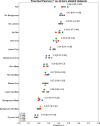Topographic Clinical Insights From Deep Learning-Based Geographic Atrophy Progression Prediction
- PMID: 39102242
- PMCID: PMC11309039
- DOI: 10.1167/tvst.13.8.6
Topographic Clinical Insights From Deep Learning-Based Geographic Atrophy Progression Prediction
Abstract
Purpose: To explore the contributions of fundus autofluorescence (FAF) topographic imaging features to the performance of convolutional neural network-based deep learning (DL) algorithms in predicting geographic atrophy (GA) growth rate.
Methods: Retrospective study with data from study eyes from three clinical trials (NCT02247479, NCT02247531, NCT02479386) in GA. The algorithm was initially trained with full FAF images, and its performance was considered benchmark. Ablation experiments investigated the contribution of imaging features to the performance of the algorithms. Three FAF image regions were defined relative to GA: Lesion, Rim, and Background. For No Lesion, No Rim, and No Background datasets, a single region of interest was removed at a time. For Lesion, Rim, and Background Shuffled datasets, individual region pixels were randomly shuffled. For Lesion, Rim, and Background Mask datasets, masks of the regions were used. A Convex Hull dataset was generated to evaluate the importance of lesion size. Squared Pearson correlation (r2) was used to compare the predictive performance of ablated datasets relative to the benchmark.
Results: The Rim region influenced r2 more than the other two regions in all experiments, indicating the most relevant contribution of this region to the performance of the algorithms. In addition, similar performance was observed for all regions when pixels were shuffled or only a mask was used, indicating intensity information was not independently informative without textural context.
Conclusions: These ablation experiments enabled topographic clinical insights on FAF images from a DL-based GA progression prediction algorithm.
Translational relevance: Results from this study may lead to new insights on GA progression prediction.
Conflict of interest statement
Disclosure:
Figures





References
-
- Schmitz-Valckenberg S, Pfau M, Fleckenstein M, et al. .. Fundus autofluorescence imaging. Prog Retin Eye Res. 2021; 81: 100893. - PubMed
-
- Holekamp N, Wykoff CC, Schmitz-Valckenberg S, et al. .. Natural history of geographic atrophy secondary to age-related macular degeneration: results from the prospective Proxima A and B clinical trials. Ophthalmology. 2020; 127: 769–783. - PubMed
Publication types
MeSH terms
Associated data
LinkOut - more resources
Full Text Sources
Medical

